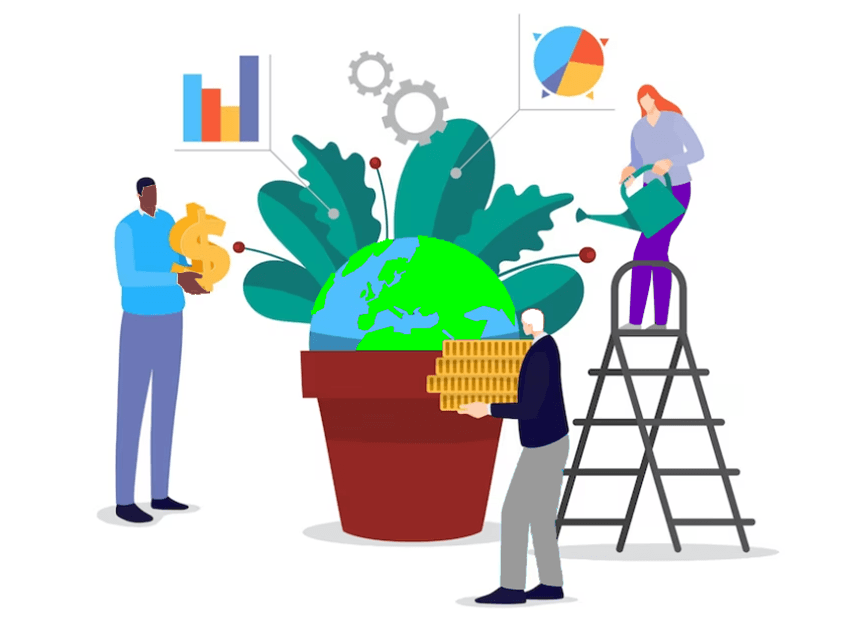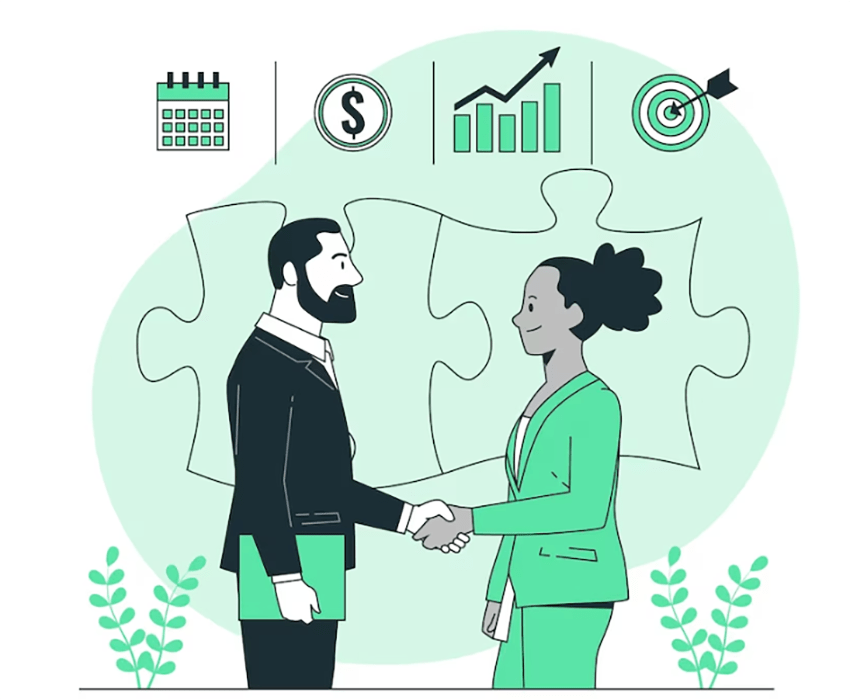We’ve all heard of the proverbial “win-win”. The win-win is where both or all parties involved in a negotiation come out with things they want. However, this win-win only takes into account the needs and wants of the humans involved in the arrangement. It is often at the expense of the natural environment and possibly other people. When we talk about the win-win to achieve sustainability, it means taking into account the environment and other people not directly involved.
Samantha’s story*
Samantha stood facing the mixed-gender boardroom of grey and black suits and ties. She felt out of place in her bright, multicoloured maxi-dress. However, it was who she was. She was a creative, hired to develop innovative solutions to complex, wicked problems.
Samantha took a deep breath. “Some people could view buying carbon credits as greenwashing. The Company isn’t actually putting back into the environment what it is taking.” She paused. The silence was deafening. “My proposal is this. We should collaborate with the Indigenous population on whose sacred lands The Company has historically destroyed to rehabilitate the lands.”
Stony faces stared at her.
To be continued…
*Samantha’s story is a work of fiction, including characters, circumstances, and location.

Source: Freepik.
Positive Partnerships to achieve sustainability. What do we mean?
Positive: having a good or favourable effect.
Merriam Webster Dictionary
Partnership: an agreement between organisations, people and others to work together.
Cambridge Dictionary
What Is A Positive Partnership?
A positive partnership is when people or groups work together with trust, respect, and common goals. In fact, with these partnerships, everyone collaborates, communicates well, and actively contributes to reach shared objectives. These relationships thrive on honesty, cooperation, and a positive problem-solving approach, leading to mutual benefits and shared achievements. As a result, positive partnerships aim for everyone to win, making it a win-win situation for all involved.
What is Corporate Social Responsibility (CSR)?
CSR means a company takes responsibility for how it affects society and the environment. Indeed, it’s about incorporating ethical, social, and environmental concerns into how a company does business and interacts with different people and groups like employees, customers, suppliers, communities, and shareholders. Companies practising CSR work to positively impact society, promote sustainable development, and tackle social and environmental issues. CSR activities can involve things like donating to charities, conserving the environment, ethical business practices, supporting community development, and encouraging employees to volunteer, among other socially responsible actions.
Why is it essential that we focus on Positive Partnerships to achieve sustainability?
Teaming up in positive partnerships is crucial for sustainability. Working together brings fresh ideas and solutions, and when responsibilities are shared, everyone stays committed for the long term. Moreover, these partnerships have a big impact, influencing policies and benefiting local communities. Trust and openness are vital, making these partnerships strong and adaptable. In a nutshell, positive partnerships create lasting, positive changes by bringing people and ideas together.
moving forward to achieve sustainability
Samantha’s story
…continued.
The CEO spoke from the head of the table. “Do you have a plan?”
Samantha smoothed her dress, nodded her head, and replied, “Yes. In fact, several elders of the tribes impacted have expressed interest in this. The elders also agreed that if the proposal were to be approved, they would be more than happy to allow non-Indigenous people onto the land to assist in the rehabilitation. Furthermore, they would consider sharing other lands, that are not considered sacred, with The Company in the future.”
Without smiling, the CEO stood up and walked to Samantha. She grabbed Samantha’s hand and pumped it furiously. “That sounds like a marvellous idea. If you lead the project, I’ll back it. The Company will be more than happy to accept its CSR.”

Source: Freepik.
achieving the United Nations Sustainable Development Goals (SDGs) and how they link to Positive Partnerships
The 2030 Agenda for Sustainable Development, adopted by all United Nations Member States in 2015, provides a shared blueprint for peace and prosperity for people and the planet, now and into the future. At its heart are the 17 Sustainable Development Goals (SDGs), which are an urgent call for action by all countries – developed and developing – in a global partnership.
United Nations
In simple terms, CSR supports all the goals of the SDGs. Indeed, it does this by inspiring businesses to get involved in social and environmental projects like fighting poverty, promoting gender equality, using clean energy, and responsible production. This means companies are working towards global sustainability aims. CSR also encourages businesses to be transparent and accountable, promoting fair economic growth, protecting the environment, and improving social welfare. In short, CSR plays a vital role in helping the United Nations achieve its Sustainable Development Goals.
However, one of the most important and broadest goals of all is SDG 17, which focuses on global partnerships for sustainability. To clarify, CSR promotes partnerships (SDG 17.16) and gathers resources (SDG 17.17) to support worldwide sustainable development and cooperation.
In fact, without partnerships, people won’t achieve any of the SDGs. It will take collaboration at the individual, community, local, state, federal, and international levels between all stakeholders on planet Earth. That means everybody.
A Thrivable Framework
A Framework To Achieve Sustainability
THRIVE stands for The Holistic Regenerative Innovative Value Entity. It forms the basis for the THRIVE Framework and is a transdisciplinary, holistic modelling system. As a result, likely outcomes of actions can be modelled well before they occur. In fact, the purpose of the THRIVE Framework is to help measure the potential of initiatives taken today to help transform society towards a ‘better than sustainable’ future. Being ‘Thrivable’ is being involved in problem-solving as each person affects and changes the world.
The Framework is underpinned by 12 Foundational Focus Factors. Moreover, these are theories and guidelines that can steer humanity, navigating and charting ways of living and working through crises, natural disasters and climate change. Furthermore, the THRIVE Framework is relevant to CSR in various ways.
Materiality
Materiality means what is significant and relevant to an entity, whether an individual, company, or nation. Indeed, sustainability materiality goes beyond the simply financial to take in the big picture view of the entire situation, including impacts and profits. There is no point in making a profit if everything is destroyed in its wake.
Moreover, materiality in the context of CSR refers to identifying and addressing issues that are most relevant and significant to both the company and its stakeholders. Furthermore, CSR initiatives should focus on material issues, ensuring meaningful impact and transparency.
Integral Thinking
Integral thinking surpasses conventional linear problem-solving approaches by incorporating multi-capital and reporting aspects beyond the triple bottom line. In fact, this method enables organisations aiming to balance social and economic aspects to comprehend the extensive effects of their actions, exploring the interconnectedness of social, economic, and environmental impacts within groups, products, or services.
CSR means businesses doing good for society. As a result, integral thinking helps them see the bigger picture, considering social, environmental, and economic aspects for a more meaningful impact.
Complex, Wicked Problems
A wicked problem is a social, cultural, political, or economic problem that is difficult to solve. It results from volatile, uncertain, complex, and ambiguous circumstances.
CSR addresses complex, wicked problems by promoting responsible business practices and collaborative solutions, aiming to create positive social and environmental impacts in the face of challenging, interconnected issues.
THRIVE’s Logo
THRIVE’s logo, a ciambella chart, outlines two important boundaries for humanity to adhere to. Furthermore, these boundaries are – a social floor, denoting the minimum for an entity’s survival; and an environmental ceiling, where too many resources are taken from the environment. CSR aims to keep humanity within the two boundaries by accepting their responsibilities. In fact, innovating opportunities for economic growth ensures meeting social needs and prevents them from overtaking the environment.
Further Resources
THRIVE researches, educates, and advocates for a thrivable future for all. If you want further information, you can read our informative blog, subscribe to our YouTube channel, sign up for our newsletter, listen to our podcast, or join our informative live webinars.























